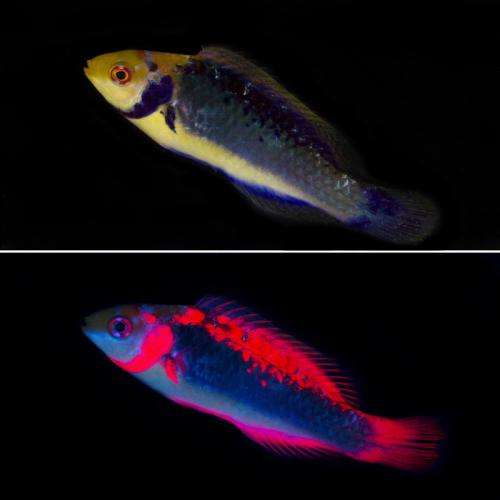July 16, 2014 report
Researchers find red fluorescence in fish is for vision not UV protection

(Phys.org) —A team of researchers with members from Germany and Egypt has found that red fluorescence as found in many species of fish appears to be for visual purposes, rather than as a UV protection mechanism. In their paper published in Proceedings of the Royal Society B: Biological Sciences, the team describes how they captured and tested several species of fish with red fluorescence and found that those that lived in deeper water had more fluorescence, not less, than those that lived in more shallow water.
We humans see things as the color they appear to us because the material they are made of absorbs some of the light spectrum and bounces back other parts. With fluorescence, things are a little different, instead of bouncing back some wavelengths, light is absorbed and then the organism emits another longer wavelength. In the case of many fish, that wavelength is seen by us humans as red, which really stands out as sunlight is filtered by seawater—blues and greens travel deeper than reds and other colors. Thus, without fluorescence, red fish would not appear red in deep water. But why do some fish have red fluorescence at all? Scientists have two theories, one is that it's a byproduct of a form of UV protection. The other is that it serves some sort of visual purpose for the fish—to attract others perhaps, or to ward off predators. To learn more, the researchers ventured to various sites in the Red Sea, the East Indian Ocean and the Mediterranean Sea to collect samples of several species and test them.
To learn more about the purpose of their red fluorescence the researchers collected fish samples from several depths, ranging from 5 to 20 meters. All of the specimens were taken to a lab where they were tested to see how strong they fluoresce—the thinking was that if fluorescence was for UV protection, then those that lived in deeper waters would fluoresce less as they wouldn't need as much protection. In analyzing their results, the researchers found the opposite—fish that lived in deeper waters fluoresced stronger than those that lived in shallow waters, indicating that fluorescence, at least for them, was not tied to UV protection. The assumption now is that the fluorescence must serve a visual purpose.
The researchers plan to continue their study by testing fish in their natural environment and to try to find out if fluorescence around the eyes is used to help navigate in dark water.
More information: Melissa G. Meadows, Nils Anthes, Sandra Dangelmayer, Magdy A. Alwany, Tobias Gerlach, Gregor Schulte, Dennis Sprenger, Jennifer Theobald and Nico K. Michiels: "Red fluorescence increases with depth in reef fishes, supporting a visual function, not UV protection." Proceedings of the Royal Society B, DOI: 10.1098/rspb.2014.1211
Abstract
Why do some marine fishes exhibit striking patterns of natural red fluorescence? In this study, we contrast two non-exclusive hypotheses: (i) that UV absorption by fluorescent pigments offers significant photoprotection in shallow water, where UV irradiance is strongest; and (ii) that red fluorescence enhances visual contrast at depths below −10 m, where most light in the 'red' 600–700 nm range has been absorbed. Whereas the photoprotection hypothesis predicts fluorescence to be stronger near the surface and weaker in deeper water, the visual contrast hypothesis predicts the opposite. We used fluorometry to measure red fluorescence brightness in vivo in individuals belonging to eight common small reef fish species with conspicuously red fluorescent eyes. Fluorescence was significantly brighter in specimens from the −20 m sites than in those from −5 m sites in six out of eight species. No difference was found in the remaining two. Our results support the visual contrast hypothesis. We discuss the possible roles fluorescence may play in fish visual ecology and highlight the possibility that fluorescent light emission from the eyes in particular may be used to detect cryptic prey.
Journal information: Proceedings of the Royal Society B
© 2014 Phys.org





















